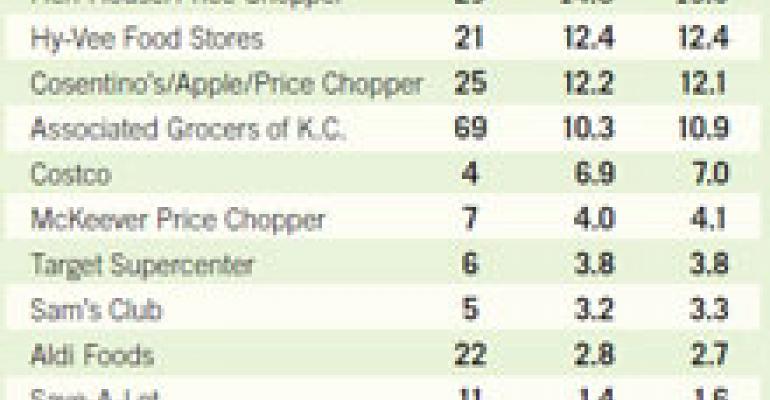A DIVERSE ECONOMY and a relatively low cost of living even in the boom years helped the Kansas City, Mo., market weather the economic downturn better than its counterparts on either coast.

Its grocery store mix reflects that stability, with Wal-Mart Stores, family-run independents and regional chains making up the majority of the mix there, although some observers say there's unmet demand for the specialty stores and natural/organic merchants that some other cities have.
These stores may grow some in Kansas City as the economy recovers, observers say. In the meantime, the market is a battleground between conventional operators such as West Des Moines, Iowa-based Hy-Vee and a variety of independents either owned by or doing business with Associated Wholesale Grocers, the hometown wholesale cooperative.
The Kansas City metro area encompasses 15 counties in Kansas and Missouri with a population of about 2 million, according to Tucson, Ariz.-based Metro Market Studies. Its buying income and food sales index higher than the national averages, Metro Market noted.
While many areas of the country were crippled by the economy in 2008 and 2009, Kansas City felt only a slight slowdown, local sources say. A recovery — which may also bring additional competition to the market — may already be underway.
“Retail in general fell in Kansas City fell some over the last 18 months, but not to the degree that other places have,” Dave Clafin, vice president of marketing for RED Development, Kansas City, told SN in an interview. “It's definitely been feeling healthy for the last three months.”
According to Clafin, a certain lack of glitz — even among grocery offerings — has served Kansas City well in recent times.
“We are somewhat immune to the real high highs and low lows that other parts of the country are experiencing,” he said. “We're more of what I'd call a real economy — there's no one sector we have to rely on; we're not dependent on semiconductors or something that runs real hot and cool. We also don't have a lot of the geographic gifts that some other areas have, where you'll sell your tech business and you've got $10 million in your pocket, you're probably not going to choose Kansas City as the place to build your dream home, unless you're from here. So we don't have that influx of money from elsewhere driving up prices irrationally.”
Grocery market share in the area is led by Wal-Mart, which operates 26 outlets, including three Neighborhood Market stores. Wal-Mart opened or converted to grocery four new stores in Kansas City last year, including a newly relocated store in Raytown, Mo. It controls 23.8% of the total share.
Conventional grocery operators are locked in a tight battle for the next slots. Balls Food Stores, which operates 29 stores under the Ball's Price Chopper and more upscale Hen House Market trade names, is second with a 14.8% share, followed by Hy-Vee Stores (21 stores, 12.4% share) and Cosentino's Food Stores, which like Balls, is a family-run independent operating stores under multiple banners (Cosentino's, Apple Market, Price Chopper and Sun Fresh). AWG co-op independents under the Piggly Wiggly, Apple, Cash & Carry, Sun Fresh, Price Chopper and Thriftway names account for 69 stores and a 10.3% share.
Cosentino's was in the news last year for opening a new store in downtown Kansas City, the city's first in some 40 years. Cosentino's Downtown Market was modeled in the style of urban stores in other cities, with an emphasis on prepared foods, floral and a large beer and wine selection serving daytime workers and young area residents.
Despite this arrival, Kansas City remains relatively light on boutique and specialty grocers, Clafin said.
“In grocery there is an opportunity for organic and more uniquely positioned brands,” he said. “We have got our share of Costcos and Sam's Clubs and we've got a number of A-plus, full-service grocers that stock the normal brands. But there's only two Whole Foods, and there's no Trader Joe's here yet. Dean & DeLuca has a good carry-out, salad bar type grocery business, but I think there's more opportunity for that here.”
Residential growth, particularly to the south and west of the city, has slowed with the economic downturn, but Clafin said he sees opportunity coming via in-fill sites.





